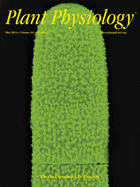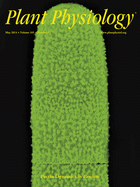
Cover image

On the Cover: Cell walls constitute complex composites of macromolecules that are of profound importance to the life of plant cells. Synthesized and secreted by highly dynamic biosynthetic machinery, the polymeric constituents must be accurately deposited into the microarchitecture of the wall in order for it to function competently. Presently, these structural and developmental properties, especially as they contribute to interactive polymeric networks in the wall, are poorly resolved. In this issue, Domozych et al. (pp. 105–118) employ the unicellular charophyte green alga, Penium margaritaceum, to investigate pectin architecture and dynamics in the cell wall. The outer layer of the wall is comprised of homogalacturonan fibrils that form dense aggregates that organize into a distinct outer lattice. Changes to lattice architecture may be directly monitored in live cells grown under different experimental conditions. This includes variations in levels of cations (e.g. calcium), exogenous pectin, pectin methylesterase, and pectate lyase. Pectin deposition is focused at a thin band at the cell isthmus and is part of a wall expansion mechanism that occurs in a distinct bidirectional fashion. These results highlight the efficiency of P. margaritaceum as a unicellular model organism for cell wall studies and provide new insight into pectin-based functions, including adhesion and cell shape maintenance. The cover shows the outer pectin lattice of the cell wall labeled with the anti-homogalacturonan monoclonal antibody, LM18. Cover image credits: David Domozych.
Volume 165, Issue 1, May 2014
ON THE INSIDE
On the Inside
BREAKTHROUGH TECHNOLOGIES
High-Efficiency Stable Transformation of the Model Fern Species Ceratopteris richardii via Microparticle Bombardment
A highly efficient method transforms fern callus tissue, with rapid and simple selection for stable transgenic lines through antibiotic selection.
New Generation of Artificial MicroRNA and Synthetic Trans-Acting Small Interfering RNA Vectors for Efficient Gene Silencing in Arabidopsis
Artificial microRNAs and synthetic trans-acting small interfering RNAs produced from new, high-efficiency expression vectors induce reliable gene silencing in Arabidopsis.
RESEARCH REPORTS
Multigene Engineering of Triacylglycerol Metabolism Boosts Seed Oil Content in Arabidopsis
Transgenes specifically targeting fatty acid synthesis, triacylglycerol synthesis, and triacylglycerol breakdown lead to an additive effect on seed oil content in Arabidopsis.
Articles
BIOCHEMISTRY AND METABOLISM
Metabolic Flux Analysis of Plastidic Isoprenoid Biosynthesis in Poplar Leaves Emitting and Nonemitting Isoprene
Isoprene biosynthesis demands a huge carbon flux through the plastidic isoprenoid pathway, and the concentration of its immediate precursor modulates this flux.
Plants Utilize a Highly Conserved System for Repair of NADH and NADPH Hydrates
The hydrates formed from NADH and NADPH by chemical or enzymatic damage are repaired in plants by highly conserved enzymes that are targeted to multiple compartments.
Evolutionary Convergence of Cell-Specific Gene Expression in Independent Lineages of C4 Grasses
Maize and Setaria viridis have independently recruited syntenic orthologs into the C4 pathway, and transcript abundance in the mesophyll and bundle sheath cells of these species is highly convergent.
Pepper Suppressor of the G2 Allele of skp1 Interacts with the Receptor-Like Cytoplasmic Kinase1 and Type III Effector AvrBsT and Promotes the Hypersensitive Cell Death Response in a Phosphorylation-Dependent Manner
A pepper receptor-like cytoplasmic kinase and Xanthomonas effector complex promote cell death in a phosphorylation-dependent manner.
The Mitochondrial Sulfur Dioxygenase ETHYLMALONIC ENCEPHALOPATHY PROTEIN1 Is Required for Amino Acid Catabolism during Carbohydrate Starvation and Embryo Development in Arabidopsis
A mitochondrial pathway oxidizes hydrogen sulfide or persulfides derived from amino acid catabolism to thiosulfate and affects alternative respiration during carbohydrate starvation.
Hypoosmotic Expression of Dunaliella bardawil ζ-Carotene Desaturase Is Attributed to a Hypoosmolarity-Responsive Element Different from Other Key Carotenogenic Genes
Expression of Dunaliella bardawil ζ-carotene desaturase is attributed to a hypoosmolarity-responsive element different from other key carotenogenic genes.
Functional Analysis of 3-Hydroxy-3-Methylglutaryl Coenzyme A Reductase Encoding Genes in Triterpene Saponin-Producing Ginseng
Coenzyme A reductases contribute to the production of triterpene saponin in ginseng.
Unraveling Vitamin B12-Responsive Gene Regulation in Algae
Characteristics of vitamin B12-mediated gene regulation in algae provide insight into the evolution of vitamin B12 auxotrophy.
Comparing the in Vivo Function of α-Carboxysomes and β-Carboxysomes in Two Model Cyanobacteria
Despite evolutionary and structural differences between carboxysomes, Rubisco kinetics and in vivo performance are similar.
CELL BIOLOGY
Pectin Metabolism and Assembly in the Cell Wall of the Charophyte Green Alga Penium margaritaceum
The charophyte green alga Penium margaritaceum possesses an experimentally tractable pectin domain in its cell wall that offers insight into wall assembly and polar growth in plants.
Plastid Osmotic Stress Activates Cellular Stress Responses in Arabidopsis
Organelles as intracellular osmosensors: Arabidopsis mutants unable to relieve plastid osmotic stress constitutively activate the same cellular responses as environmental osmotic stress.
Dynamics and Organization of Cortical Microtubules as Revealed by Superresolution Structured Illumination Microscopy
The dynamic organization of cortical microtubules in plant cells is uncovered using structured illumination superresolution microscopy.
GENES, DEVELOPMENT, AND EVOLUTION
A Comprehensive Analysis of MicroProteins Reveals Their Potentially Widespread Mechanism of Transcriptional Regulation
Transcription factor-like proteins without a DNA binding domain, are involved in a potentially ubiquitous layer of transcriptional regulation.
OsmiR396d-Regulated OsGRFs Function in Floral Organogenesis in Rice through Binding to Their Targets OsJMJ706 and OsCR4
MicroRNA-regulated growth-regulating factors activate expression of specific targets to regulate floral organ development, affecting characteristics such as husk openness and sterile lemma length.
New Arabidopsis Advanced Intercross Recombinant Inbred Lines Reveal Female Control of Nonrandom Mating
A genetic mapping population is developed and reveals female control of mating choice in plants.
Non-Cell-Autonomous Regulation of Root Hair Patterning Genes by WRKY75 in Arabidopsis
The WRKY75 transcription factor is expressed in the pericycle and vascular tissues of the root and regulates root hair patterning in a non-cell-autonomous manner.
Truncation of LEAFY COTYLEDON1 Protein Is Required for Asexual Reproduction in Kalanchoë daigremontiana
A mutated master regulator of zygotic embryogenesis is essential for creating somatic embryos and enhancing asexual propagation in Kalanchoë.
Evolution of Gene Structural Complexity: An Alternative-Splicing-Based Model Accounts for Intron-Containing Retrogenes
An alternative-splicing-based model explains the formation of retrogenes that retained the parental intron structure and indicates that plants have a much higher percentage of this kind of complex retrogene than animals.
Hybridization Alters Spontaneous Mutation Rates in a Parent-of-Origin-Dependent Fashion in Arabidopsis
Hybridization alters mutation rates in Arabidopsis.
MEMBRANES, TRANSPORT, AND BIOENERGETICS
The Arabidopsis Protein CONSERVED ONLY IN THE GREEN LINEAGE160 Promotes the Assembly of the Membranous Part of the Chloroplast ATP Synthase
A thylakoid membrane protein promotes the assembly of the protein complex that generates ATP in chloroplasts.
Proton Gradient Regulation 5-Mediated Cyclic Electron Flow under ATP- or Redox-Limited Conditions: A Study of ƊATPase pgr5 and ƊrbcL pgr5 Mutants in the Green Alga Chlamydomonas reinhardtii
The Chlamydomonas reinhardtii pgr5 mutant shows photosynthetic and phenotypic traits that support the conservation of PGR5 in both redox-controlled cyclic electron flow and PSI photoprotection.
The Response of Cyclic Electron Flow around Photosystem I to Changes in Photorespiration and Nitrate Assimilation
Cyclic electron flow (CEF) contributes to balancing the photosynthetic ATP/NADPH energy budget under high but not low light according to modeled ATP and NADPH demand and does not respond to changes in nitrate availability.
The Redox Potential of the Plastoquinone Pool of the Cyanobacterium Synechocystis Species Strain PCC 6803 Is under Strict Homeostatic Control
The redox state of the plastoquinone pool of Synechocystis sp. strain PCC 6803 is regulated between narrow limits, in contrast to the more dynamic chlorophyll a fluorescence signal.
SIGNALING AND RESPONSE
A Subfamily of Putative Cytokinin Receptors Is Revealed by an Analysis of the Evolution of the Two-Component Signaling System of Plants
Phylogenetic analysis of members of the two-component signaling system identifies a previously unknown subfamily of putative cytokinin receptors.
Rice Fertilization-Independent Endosperm1 Regulates Seed Size under Heat Stress by Controlling Early Endosperm Development
Early seed development in rice is highly sensitive to heat stress and negatively affects seed enlargement because of epigenetic misregulation of endosperm development.
Singlet Oxygen Signatures Are Detected Independent of Light or Chloroplasts in Response to Multiple Stresses
Diverse stresses can produce singlet oxygen in a light-independent manner and generate a singlet oxygen transcriptome footprint.
The Arabidopsis LYSIN MOTIF-CONTAINING RECEPTOR-LIKE KINASE3 Regulates the Cross Talk between Immunity and Abscisic Acid Responses
An Arabidopsis receptor-like kinase negatively regulates defense gene expression and resistance against microbial pathogens and is required for late responses to abscisic acid.
Abscisic Acid Uridine Diphosphate Glucosyltransferases Play a Crucial Role in Abscisic Acid Homeostasis in Arabidopsis
A glucosyltransferase and its two homologs play a critical role in ABA homeostasis by converting active ABA to an inactive ABA conjugate depending on intrinsic cellular and environmental conditions in plants.
Accumulation of N-Acetylglucosamine Oligomers in the Plant Cell Wall Affects Plant Architecture in a Dose-Dependent and Conditional Manner
In planta accumulation of short chitin oligomers results in a strong conditional phenotype.
Monoubiquitination of Histone 2B at the Disease Resistance Gene Locus Regulates Its Expression and Impacts Immune Responses in Arabidopsis
Histone modification at the plant immune receptor gene modulates immune responses in Arabidopsis.
The Heat Shock Factor A4A Confers Salt Tolerance and Is Regulated by Oxidative Stress and the Mitogen-Activated Protein Kinases MPK3 and MPK6
An Arabidopsis Heat Shock Factor affects tolerance to salt as well as other abiotic stresses, forms homodimers dependent on the redox regulation, interacts with MAP kinases, and alters the expression of a large set of stress-induced genes.
Two Rice Authentic Histidine Phosphotransfer Proteins, OsAHP1 and OsAHP2, Mediate Cytokinin Signaling and Stress Responses in Rice
Rice His phosphotransfer proteins function as positive regulators of the cytokinin signaling pathway and play different roles in salt and drought tolerance in rice.
Secreted Fungal Effector Lipase Releases Free Fatty Acids to Inhibit Innate Immunity-Related Callose Formation during Wheat Head Infection
A lipase secreted by a pathogenic fungus during wheat head infection acts as an effector to inhibit the plant’s innate immunity-related callose biosynthesis for successful colonization.


